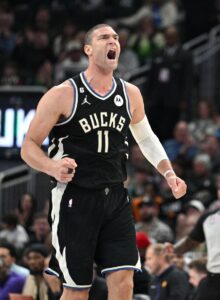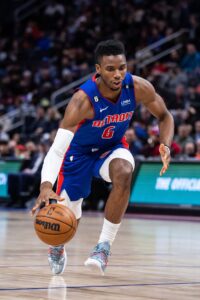Following a recent hot streak by the Hornets, three clubs have separated themselves from the pack in the NBA’s race to the bottom. Barring a major surprise, the Pistons (15-51), Rockets (15-50), and Spurs (16-49) will finish as the NBA’s worst three teams.
Even if Charlotte (21-46) doesn’t pick up another win for the rest of the season, San Antonio would have to go 5-12 the rest of the way to tie the Hornets in the standings. That may not sound like a tall order, but it has taken the Spurs 31 games to get their last five wins.
Detroit and Houston would need six more victories to have even a remote shot at catching the Hornets — it has taken the Pistons 28 games to get their last six wins and the Rockets 33 games to do so.
Given that the Hornets have actually been quite competitive lately and no other team has fewer than 27 victories, we should be able to safely pencil in the Pistons, Rockets, and Spurs as the three teams who will have a 14% shot at the No. 1 pick in this May’s draft lottery.
Of course, even though the NBA’s worst three teams will have equal odds to land the No. 1 pick (and a top-four pick), it still pays to finish at the very bottom of the standings — the NBA’s worst team can’t fall out of the top five as a result of the lottery, whereas its third-worst team could theoretically slide all the way to No. 7.
However, there’s another intriguing subplot in this three-team “race.” The Rockets’ final place in the standings will have a major impact on where a pair of Eastern Conference clubs are drafting in the second round this June.
The Pistons and Spurs control their own second-round picks, but due to a series of trades, protections, and swaps, the Rockets’ second-round pick will be sent to either the Pacers or the Celtics. Indiana will get it if it lands at No. 31 or No. 32, while Boston would receive it if it’s No. 33 (or later). Whichever team doesn’t get Houston’s second-round selection would instead end up with the least favorable of the Mavericks’ and Heat’s second-rounders. As of today, that’d be Miami’s pick at No. 50.
[Note: Boston would have the ability to swap that second-round pick for Portland’s second-rounder, but Indiana wouldn’t.]
You’re almost definitely not going to find a franchise player in the early 30s of a draft, but the hit rate on those picks might be a little better than you think. From 2018-21, for instance, players selected in the 30-36 range included Jalen Brunson, Devonte’ Graham, Mitchell Robinson, Kevin Porter Jr., Nic Claxton, Cody Martin, Desmond Bane, and Herbert Jones.
The Pacers know first-hand the value of having an early second-round pick, having used the No. 31 selection in the 2022 draft to nab Andrew Nembhard. Head coach Rick Carlisle has expressed a belief that Nembhard will end up being a top-12 or top-15 player in the ’22 class.
If a team isn’t zeroed in on a specific player in that section of the draft, an early second-round pick could be used as a valuable trade chip that secures multiple future second-rounders or a veteran rotation player. Again, this is something the Pacers know from experience — it cost them four second-rounders to acquire the No. 31 pick in the 2021 draft. And in 2019, they were able to acquire T.J. Warren and three future second-rounders in exchange for that year’s No. 32 pick and a little cash.
Conversely, a pick in the range of No. 50 (which is where the less favorable of Miami’s and Dallas’ pick figures to end up) is more likely to be used on a two-way player. In terms of trade value, you’d be hard-pressed to get more than cash or perhaps a single far-off second-round pick.
Determining where Houston’s second-round pick will land obviously won’t be nearly as dramatic as learning which team wins the Victor Wembanyama sweepstakes, but the impact on the Pacers and Celtics won’t be insignificant. Boston will be rooting for the Rockets to finish the season strong, moving that pick to No. 33, while Indiana will be hoping for another extended losing streak in Houston.
 Lopez has been one of the NBA’s best stories this season, rebounding from a mostly lost season in 2021/22 after undergoing back surgery (he played just 13 regular season games and 12 playoff games). He’s having an outstanding year and has been a major factor in Milwaukee’s league-leading 44-17 record, averaging 14.7 PPG, 6.7 RPG and 2.4 BPG on .508/.370/.766 shooting through 60 games (30.3 MPG).
Lopez has been one of the NBA’s best stories this season, rebounding from a mostly lost season in 2021/22 after undergoing back surgery (he played just 13 regular season games and 12 playoff games). He’s having an outstanding year and has been a major factor in Milwaukee’s league-leading 44-17 record, averaging 14.7 PPG, 6.7 RPG and 2.4 BPG on .508/.370/.766 shooting through 60 games (30.3 MPG). Diallo is challenging to evaluate because his strengths and weakness are more pronounced than most players. He is a non-shooting wing with pretty bad tunnel vision, which you would expect would make him ineffective in a league constantly looking for floor-spacers.
Diallo is challenging to evaluate because his strengths and weakness are more pronounced than most players. He is a non-shooting wing with pretty bad tunnel vision, which you would expect would make him ineffective in a league constantly looking for floor-spacers.